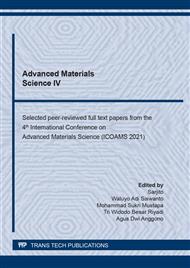p.58
p.64
p.71
p.79
p.89
p.95
p.102
p.111
p.119
Effect of Heating Time on Woven Bamboo Fiber Composites to Bending Strength
Abstract:
The research objective is to determine the maximum bending strength of woven bamboo composite materials. This material is used as a raw material for furniture. The method applied is the formation of a composition of woven bamboo with resin as an adhesive. The merging process was held at a temperature of 105°C at a time variation of 30, 45 and 60 minutes. Furthermore, bending testing is carried out and an analysis of the calculation of the Modulus of Rupture (MOR) value is carried out which is also displayed in graphic form. Based on the results of the bending test, the maximum bending strength obtained from the composite of woven bamboo and rice husk is 304.66 N. While the maximum MOR value that can be achieved is 60.05 N/mm3. The optimal bending strength was required a heating holding time of 60 minutes.
Info:
Periodical:
Pages:
89-94
Citation:
Online since:
January 2022
Authors:
Keywords:
Price:
Сopyright:
© 2022 Trans Tech Publications Ltd. All Rights Reserved
Share:
Citation:


